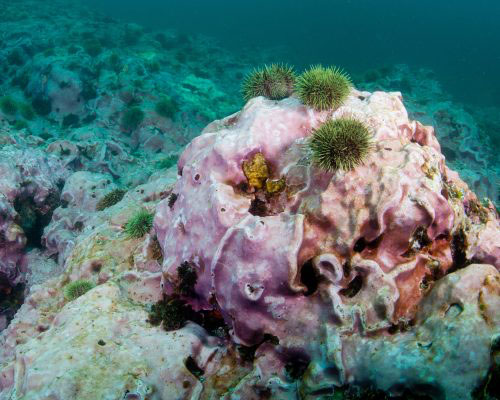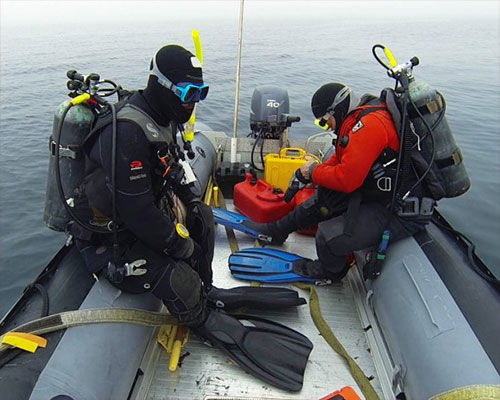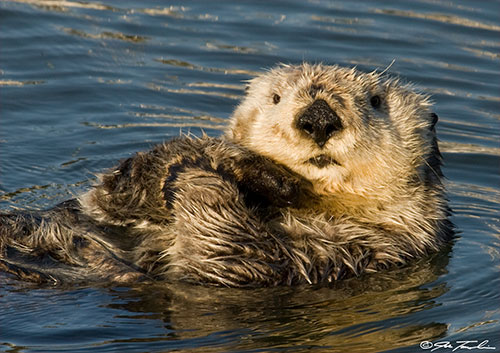
Without otter predation, sea urchins decimate Aleutian reefsBy ALICE BAILEY
September 27, 2020
Uncontrolled by sea otters, their natural predator, sea urchins are devouring the massive limestone reefs surrounding the Aleutian Islands — a process exacerbated by climate-driven changes in the marine environment, according to the study. Brenda Konar, a University of Alaska Fairbanks professor at the College of Fisheries and Ocean Sciences and a co-author of the study, began diving in the Aleutians in the 1990s, just as the Aleutian sea otter population began to crash from killer whale predation.
With otters gone, the urchin population boomed both in body size and density. They began eating more kelp, which grows on the reefs. “In the past, there would be huge, vast kelp forests that went on for miles,” Konar said. “Now there are carpets of sea urchins everywhere — some places easily have 400 urchins per square meter. Kelp forests are essentially gone in the central and western Aleutians.” The Aleutian reefs and their kelp beds serve as nursery grounds for cod and other fish. The 1,200-mile archipelago helps support the annual multibillion-dollar Bristol Bay and Bering Sea fisheries. Having decimated the kelp, urchins are now eating Clathromorphum nereostratum, the algae that creates the reefs. Large urchins are chomping away at a faster rate than the algae can grow. “These long-lived reefs are now disappearing before our eyes,” said Douglas Rasher, a senior research scientist at Bigelow Laboratory for Ocean Sciences and lead author of the study.
Researchers looking at cross sections of the algae under a microscope found that growth layers in the tissue recorded urchin grazing over time. The amount of erosion caused by urchins waxed and waned with sea otter populations. This showed that predators, or lack thereof, were critical factors in determining the vulnerability of Aleutian island reefs. But, Rasher said, “Our research shows that sea urchin grazing has become much more lethal in recent years due to the emergent effects of climate change.” The scientists replicated preindustrial, current and future seawater temperature and acidity in the lab with live Clathromorphum and urchins. They found 35 to 60 percent more grazing in current conditions than in preindustrial conditions, and even more under future conditions. “Ocean warming and acidification are making it difficult for calcifying organisms to produce their shells, in this case, the alga’s protective skeleton. This critical species has now become highly vulnerable to urchin grazing — right as urchin abundance is peaking. It’s a devastating combination,” Rasher said.
In some places, reefs that are meters thick and thousands of years old are crumbling from urchins burrowing through the weakened calcium carbonate structures. The discovery that a loss of predation can increase the effects of climate change suggests that restoring sea otters could help the Aleutian reefs. “Predators like otters reduce the size and abundance of urchins, and serve to help protect these reefs — even in the face of climate change,” said Ben Weitzman, a co-author who studied urchin grazing under Konar while a Ph.D. student at CFOS. Other contributors to the paper include Jim Estes, University of California, Santa Cruz; Bob Steneck, University of Maine; Kristy Kroeker, UCSC; Justin Ries, Northeastern University; Jochen Halfar, University of Toronto; Tim Tinker, U.S. Geological Survey, UCSC; Phoebe Chan, University of Bergen; Jan Fietzke, Geomar Helmholtz Centre for Ocean Research Kiel; Nick Kamenos, University of Glasgow; Jon Lefcheck, Smithsonian Environmental Research Center; Chris Norley, University of Western Ontario; Ben Weitzman, UAF, USGS, National Oceanic and Atmospheric Administration; and Isaac Westfield, Northeastern University. The research was funded by the U.S. National Science Foundation and the National Sciences and Engineering Council of Canada.
|
|||||||


